Beans & Grains Glossary – Learn Your Legumes (And Other Family Members)Page 4: Beans & Grains Glossary K To L This is Page 4 of an 7-page article. Click on the red links below to visit other pages. This glossary is protected by copyright and cannot be reproduced in whole or part. You are welcome to link to it.
Here are terms including kamut, kañiwa, lentil, kidney bean and lima bean. If you’d like to suggest additional words, use the Contact Us link on this page. See our many other delicious food glossaries.
|
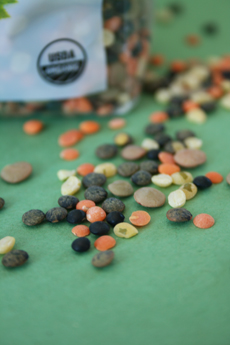 Mixed lentils: black, brown (looks tan), ivory, green (speckled), red (looks orange) and yellow. Photo by Hannah Kaminsky | THE NIBBLE. |
|
| KAMUT Kamut is a trademarked term for khorasan, the Ancient Egyptian wheat (see below). Kamut has a larger kernel than wheat and contains higher levels of protein and slightly higher levels of lipids and minerals. It is grown organically and can be purchased for use as a breakfast cereal and for bread baking. KASHA KHORASAN KAÑIHUACO
|
||
| KAÑIWA Kañiwa is closely related to quinoa, and is used in similar preparations. A hardy plant that can withstand cold temperatures, it grows in the mountains of southern Peru and Bolivia. Its numerous seeds are 1 millimeter in diameter and are dark brown to black in color. It is very high in protein with sulfur-containing amino acids; however, unlike quinoa, kañiwa has no saponins, phytochemicals that seem to reduce blood cholesterol levels and the risk of cancer and stimulate the immune system.
|
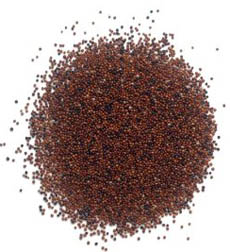 Kañiwa can be purchased from Amazon.com. |
|
| KIDNEY BEANS or RED KIDNEY BEANS Familiar to almost every American, these beans find themselves in baked beans, chili, refried beans, three bean salad (along with string beans and wax beans), Cajun bean dishes and stews. red kidney has made a name for itself as a chili bean. The most common is the dark red kidney bean, Phaseolus vulgaris, which has no markings (unlike the more elegant kidney beans shown in the photo); but there are numerous varieties, including light red kidney beans.
|
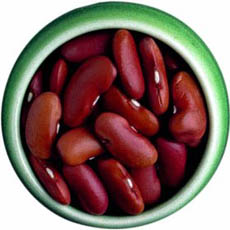 Kidney beans available at Amazon.com. |
|
| LEGUME or PULSE The edible seed of certain leguminous plants, a class of vegetables that includes beans, peas and lentils. Legumes are typically low in fat, high in fiber, cholesterol-free and high in folate, iron, magnesium and potassium. They’re also a good source of protein and can be a fat- and cholesterol-free substitute for meat. Examples include beans, chickpeas, lentils, peas and split peas. Beans and lentils are very low in fat, high in fiber and are frequently referred to as “wonder food.” Examples include adzuki beans, anasazi beans, black beans, black-eyed peas, chickpeas, edamame, fava beans, lentils, lima beans, red kidney beans and soy nuts.
|
||
| LENTIL Lentils are the seed of a small shrub and is dried after harvesting. Lentils have been eaten for over 8,000 years and originated in southwestern Asia along the Indus River. It is a staple food for many South Asian cultures.Tiny, flat and round, lentils are the fastest cooking of all dried beans that yield a rich, earthy flavor when cooked. The three major varieties are Le Puy, the most intensely-flavored lentil, a tiny green-blue lentil grown without fertilizers in the area around Le Puy en Velay, France, which have a delicate flavor and hold their shape very well; the common green or brown lentil; and yellow and red lentils, which are a staple in Indian cooking, from the spicy Indian dish daal or dal, lentil curry, to the lentil bread daal poori. One can also find ivory lentils, golden lentils and black beluga lentils, so called because they are said to resemble pearls of beluga caviar. Lentils supply a large dose of folate (folic acid), which fights heart disease and prevent birth defects; as well as providing fiber, protein, potassium and magnesium. Lentils are fat-free and absorb spices easily. Versatile, they are used in soups, stews, salads, side dishes. Mixed lentils, showing black, brown (looks tan), green (speckled), ivory, red (looks like orange) and yellow, available from Amazon.com.
|

|
|
| LIMA BEAN or BUTTER BEAN or MADAGASCAR BEAN Among the most popular shell beans in the U.S., these smooth, flat shaped, sweet-tasting beans have a rich, starchy, meaty texture and a creamy, distinctive flavor. Lima beans are nutrient-dense and their richness generates feelings of satiety. Often referred to in some southern states as “butter beans,” lima beans date back to around 5000 B.C.E. along the coastal regions of South America; they are believed to have originated in Guatemala and Southern Mexico and are called lima after Lima, Peru, where they were discovered by the Spanish in the 1500s. Spanish explorers brought the lima bean to Europe, where it thrived in the temperate climate; the slave trade brought it to Africa. where it became one of the most vital beans on the continent. Fresh varieties of lima bean sold in their pods can sometimes be found in local markets. Before European settlers reached the Americas, a type of bean believed to be similar to the lima bean was grown by Native Americans in the southwestern and East Coast regions of the U.S. These beans were commonly inter-cropped by Native Americans with corn; hence, the origin of succotash, a side dish that combines lima beans and corn. Limas are also used in casseroles, soups and salads.
|
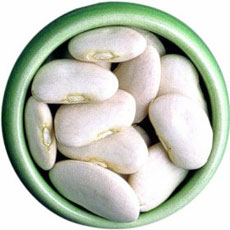 Giant Peruvian lima beans available at Amazon.com. 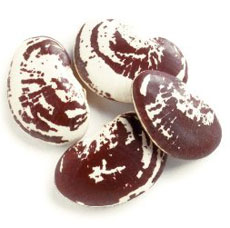 Christmas lima beans available at Amazon.com.
|
|
|
Continue To Next Page: Terms With M P Go To The Article Index Above |
||
Last Updated Apr 2018
© Copyright 2005-2025 Lifestyle Direct, Inc. All rights reserved. All images are copyrighted to their respective owners.
